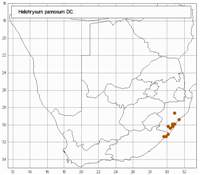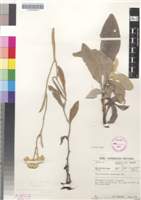Origin of name:
pannosus / -um = felted, with or appearance of felt
Diagnostic characters:
Bright yellow bractsOpen branched inflorescenceLarge woolly leaves
Description:
Perennial herb up to c. 1m high, stem from a creeping woody stock, crown brown silky-woolly, sparingly branched low down, slender, woody, brittle, often zigzag, thinly greyish white-woolly, leafy throughout. Leaves up to 100 x 20 (�30) mm, smaller upwards, oblanceolate or oblong-elliptic, lanceolate upwards, apex more or less acute, base broad, cordate-clasping, both surfaces greyish-white woolly, often drying fulvous, sometimes glabrescent, wool then clinging to the three prominent nerves. Heads homogamous, narrowly campanulate, c. 6 x 3 mm, many in tight corymbose clusters corymbosely arranged. Involucral bracts in c. 6 series, graded, closely imbricate, woolly, inner acute, glossy, lemon-yellow, about equaling flowers, not radiating. Receptacle with fimbrils about equaling ovaries. Flowers 8�15. Achenes 1 mm, faintly ribbed, glabrous. Pappus bristles many, about equaling corolla, scabrid, bases cohering by patent cilia.
Flowers mainly between April and June.
Distribution:
Ranges from Stanger, Camperdown, Pinetown and Inanda districts in KwaZulu-Natal south to Port St Johns in the Transkei, in grassland up to c. 650 m, often on hillslopes near forest patches.
Savanna, Grassland and Thicket Biomes.
Taxonomy:
Literature:
Helichrysum pannosum DC., Prodr. 6: 204 (1838); Harv. in F.C. 3: 248 (1865); Moeser in Bot. Jb. 44: 320 (1910); Hilliard, Compositae in Natal 174 (1977).
Type:
Cape, between the Umsikaba and Umzimvubu Rivers, Dr�ge 5003 (G-DC, holo.; BM; K; P; S; TCD, iso.).
Synonym(s):
Gnaphalium pannosum (DC.) Sch. Bip. in Bot. Ztg 3: 172 (1845).
Vouchers:
Hilliard 1337 (E; NU); Hilliard & Burtt 10250 (E; K; NU; S); Rudatis 957 (K; PRE); Strey 8544 (NU; PRE).
